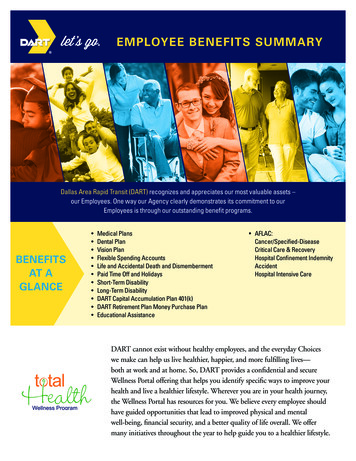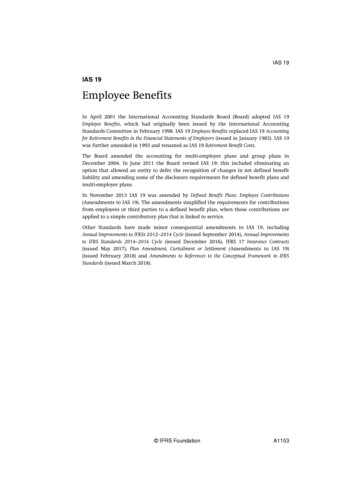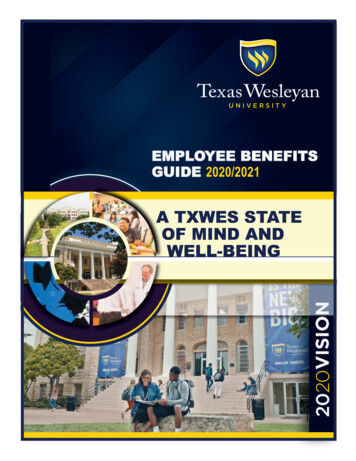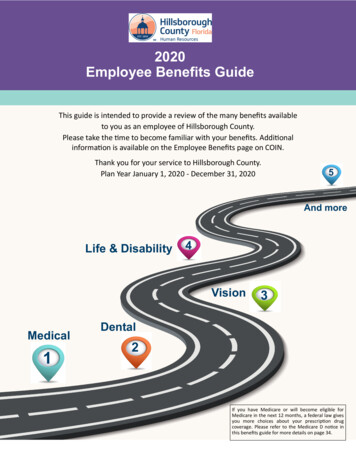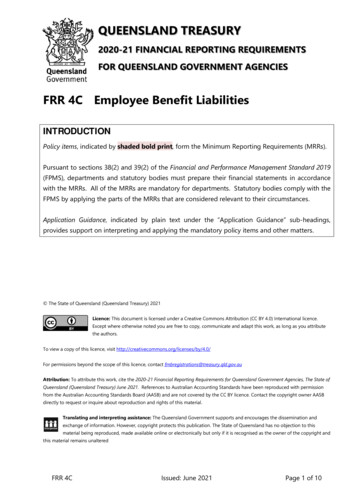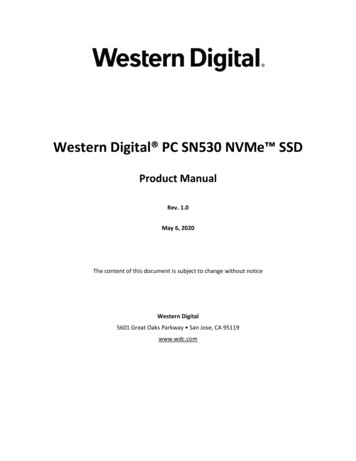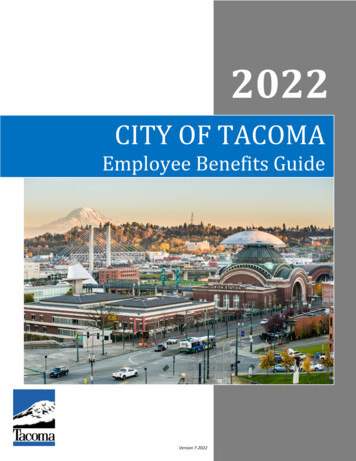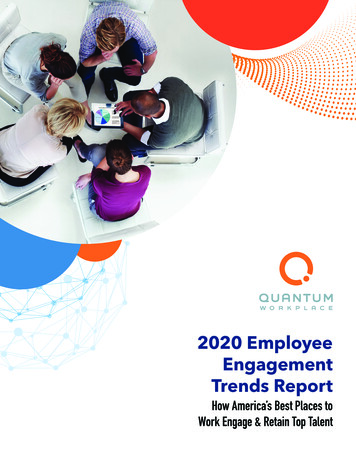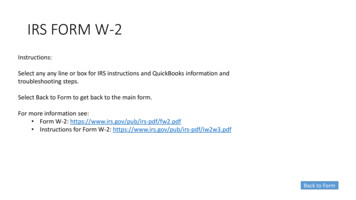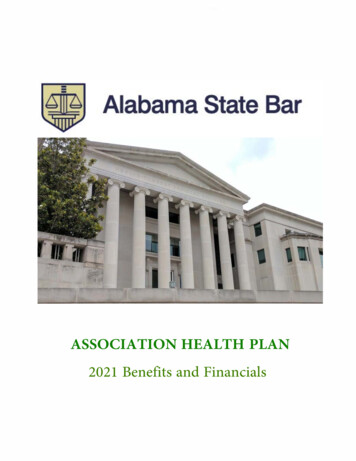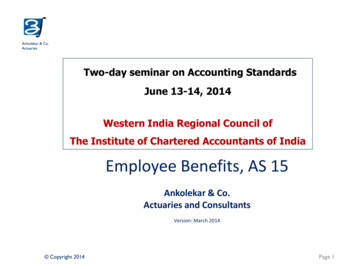
Transcription
Ankolekar & Co.ActuariesTwo-day seminar on Accounting StandardsJune 13-14, 2014Western India Regional Council ofThe Institute of Chartered Accountants of IndiaEmployee Benefits, AS 15Ankolekar & Co.Actuaries and ConsultantsVersion: March 2014 Copyright 2014Page 1
Presentation StructureAnkolekar & Co.Actuaries1. AS 15’s applicability2. Classification of Employee Benefits under AS 153. Dense Trees of ‘Post Employment Defined BenefitPlans’4. Disclosures and Presentation in Financial Statements5. Exempt Provident Funds – a new dimension6. Funding Policy7. Important Differences between AS 15 and Ind-AS 198. The ‘Not So Obvious’ Copyright 2014Page 2
Entity Classification for AS 15 (R)Ankolekar & Co.ActuariesCompanies are classified at three levels:Level I – companies which are not Small and Medium EnterprisesLevel II – companies which are Small and Medium Enterprises with 50 employeesLevel III – companies which are Small and Medium Enterprises with 50 -----The following accounting standards apply to all of Level I, II and IIIenterprises in their entirety: AS 1, 2, 4, 5, 6, 7, 8, 9, 10, 11, 12, 13, 14,15, 16, 22 and 26 Copyright 2014Page 3
Applicability of AS 15 (R)Ankolekar & Co.ActuariesAS15 is applicable in its entirety to thefollowing enterprises:1. Equity or Debt securities are listed or are inthe process of being listed2.Carrying on Insurance business3.Turnover Rs50 cr4.Borrowings Rs10 cr at any instance duringthe year5.Banks (incl co-operative banks)6.Financial Institutions7.Holding or subsidiary company of any of theaboveCompanies not falling within clauses 1 to 7are classified as Small and MediumEnterprises (SMEs).SMEs with employees above 50 need toapply the standard restrictively i.e. limiteddisclosures but value liabilities actuarially.SMEs with employees below 50 may provideliabilities on an arithmetic basis i.e. applystandard restrictively with limited disclosureand also not have liabilities valuedactuarially.
Applicability of Actuarial Valuation toPost Employment Defined Benefit & Other Long-term PlansAnkolekar & Co.ActuariesClassification of CompaniesUnder AS 15 (R)If Equity or Debt securities are listed or are in the process of being listed, orIn Insurance business, orTurnover than Rs 50 crores, orBorrowings than Rs 10 crores, orBanks (incl. co-operative banks), orFinancial Institutions, orHolding or subsidiary of any one of the aboveIf any of the criteria does not apply, then company will be aSmall and Medium Sized Company (SMC)Not a Small and Medium Sized Company (Non SMC)More than 50 employeesValuation by an Actuary with fulldisclosures of AS 15 (R)Projected UnitCredit Method Copyright 2014Valuation by anActuary; limiteddisclosures(AS 15 paras 50 to 123 i.e.detailed disclosures are notapplicable to SMC)Up to 50 employeesCompany canprovide onarithmetic/discontinuancebasis5
Need for an Actuary?Ankolekar & Co.ActuariesParagraph 49 of AS 15 reads:49. Accounting for defined benefit plans is complex because actuarial assumptions are requiredto measure the obligation and the expense and there is a possibility of actuarial gains and losses.Moreover, the obligations are measured on a discounted basis because they may be settled manyyears after the employees render the related service. While the Statement requires that it isthe responsibility of the reporting enterprise to measure the obligations under thedefined benefit plans, it is recognised that for doing so the enterprise wouldnormally use the services of a qualified actuary.Using an actuary’s services is not mandatory, but only recognised by AS 15.Note that as per paragraph 74, the assumptions of salary increase, expectedinflation and withdrawal are that of the employer (to be vetted by actuaryand more about it later in actuarial guidance note). Hence an actuarialvaluation is usually a joint effort of employer and actuary.Qualified actuary is defined as a ‘Fellow of the Institute of Actuaries of India’(APS 26 of the Institute of Actuaries of India) Copyright 2014Page 6
Presentation StructureAnkolekar & Co.Actuaries1. AS 15’s applicability2. Classification of Employee Benefits under AS 153. Dense Trees of ‘Post Employment Defined BenefitPlans’4. Disclosures and Presentation in Financial Statements5. Exempt Provident Funds – a new dimension6. Funding Policy7. Important Differences between AS 15 and Ind-AS 198. The ‘Not So Obvious’ Copyright 2014Page 7
Employee Benefits under AS-15Ankolekar & Co.ActuariesEmployee BenefitsShort term CompensatedAbsences Profit sharing andBonus PlansPost EmploymentOther LongTermTermination Defined Contribution Defined Benefits Copyright 2014ProjectedUnit CreditmethodPage 8
Employee Benefits under AS-15: headsAnkolekar & Co.ActuariesEmployee BenefitsShort term ( 12months to pay) CompensatedAbsences Profit sharing andBonus PlansPost Employment Defined Contribution- PF, DC Superannuation Defined Benefit-Pension-Gratuity- Post retirement medical- Exempt PF Copyright 2014Other Long Term- Privilege Leave- Sick Leave- Long termincentives- Loyalty bonus- ResettlementallowanceTerminationProjectedUnit CreditmethodPage 9
Employee Benefits under AS-15: DisclosureAnkolekar & Co.ActuariesEmployee BenefitsShort term ( 12months to pay) CompensatedAbsences Profit sharing andBonus PlansNo specificdisclosurePost Employment Defined Contribution- PF, DC Superannuation Defined Benefit-Pension-Gratuity- Post retirement medical- Exempt PFOther Long Term- Privilege Leave- Sick Leave- Long term incentives- Loyalty bonus- ResettlementallowanceTerminationNo specificdisclosureUnder paragraph132 of AS 15, oneline disclosurefor any co. unlessmaterial underAS 5 or AS 18Full disclosure fornon-SME, one linedisclosure for SME Copyright 2014Page 10
Short Term Employee BenefitsAnkolekar & Co.ActuariesDefinition:Employee benefits which fall due wholly within 12 months after the end of the period in whichShort termthe employee renders the related serviceBenefitsRecognition As a liability (accrued expense) after deducting any amount already paid Compensated As an expenseAbsencesDisclosuresNo specific disclosures, unless required by other accounting standards Copyright 2014 Profit sharingand Bonus PlansPage 11
Short Term Employee BenefitsAnkolekar & Co.ActuariesAccumulating Compensated Absencese.g. privilege leave which can beaccumulated for 1 year onlyWhen services rendered increase theirentitlement to future compensatedabsencesNon-accumulating compensatedabsences e.g. maternity and paternityleaveWhen absences occurProfit-sharing and bonus plansWhen a present obligation to make suchpayment arises as a result of past eventse.g. annual incentive, MD’s commission.Expected cost of accumulating compensated absences - additional amount that the enterpriseexpects to pay as a result of the unused entitlement that has accumulated at the balance sheet date. Copyright 2014Page 12
Post Employment BenefitsAnkolekar & Co.ActuariesPost Employment Benefits include: Retirement Benefits e.g. Gratuity and Pension Other Benefits e.g. Post employment medical careThey are classified asDefined Benefit PlansDefined Contribution Plans1. Obligation is limited to the amountcontributed to the fund2. Risk (Actuarial and Investment) fall onthe employeeE.g. Superannuation, Provident Fund1. Obligation is to provide agreedbenefits to the employees2. Risk (Actuarial and Investment) fallson the enterpriseE.g. Pension, Gratuity, Post employmentMedical Benefits, Exempt Providentfund Copyright 2014Page 13
Other Long-term BenefitsAnkolekar & Co.ActuariesOther Long-term Benefits include:a. Privilege Leaveb. Sick Leavec. Long term incentivesd. Loyalty bonuse. Resettlement allowanceOther long termbenefits need to beactuarially valuedusing the ProjectedUnit Credit methodas shown inparagraph 65 (seeparagraph 129)ESOP/ ESPS are not ‘OtherLong-term Benefits’(separately covered underIFRS 2/ ICAI GN 18)129. The amount recognised as a liability for other long-term employeebenefits should be the net total of the following amounts:(a) the present value of the defined benefit obligation at the balancesheet date (see paragraph 65);(b) minus the fair value at the balance sheet date of plan assets (ifany) out of which the obligations are to be settled directly (seeparagraphs 100-102).In measuring the liability, an enterprise should apply paragraphs49-91, excluding paragraphs 55 and 61. Copyright 2014Page 14
Post Employment BenefitsDefined Contribution Plan: Recognition and disclosureAnkolekar & Co.ActuariesContribution should be recognised as a liability (accrued expense), after deducting any contributionalready paid as an expense Disclosure: Amount recognised as an expense should bedisclosed Copyright 2014Page 15
Other Long Term Benefits:Recognition/ Measurement/ DisclosureAnkolekar & Co.ActuariesOther long-term employee benefits includePrivilege Leave, Sick Leave, Long term incentives , Loyalty bonus,Resettlement allowanceLiability is measured asKey DifferenceThese benefits are ‘defined benefits’but not ‘post employment’.Elaborate disclosures for ‘postemployment defined benefits’ onlyPV of the ObligationLess: Fair value of Assets at balance sheet dateRecognition----similar to Defined Benefit Plans i.e. all expenses through P&L(except unvested Past Service Cost which can be amortized over remainingvesting period)DisclosureNo specific disclosures except when amount is material as per AS 5 or AS 18 Copyright 2014Page 16
Ankolekar & Co.ActuariesTermination BenefitsAn enterprise should recognise termination benefits as a liability and an expense when: the enterprise has a present obligation as a result of a past event it is probable that an outflow will be required to settle the obligation and a reliable estimate can be made of the obligation.Termination benefits are employee benefits payable as a result ofEmployer’s decision to terminate an employee’s employmentEmployee’s decision to accept voluntary redundancy in exchange for those benefitsMeasurementBenefits that fall due 12 months after B/S date should be discountedDisclosure: When benefit is material enough When there is uncertainty about the number of employees who will opt for terminationbenefits, this contingent liability should be disclosed Where required by AS 18, disclose information about key management personnel. Copyright 2014Page 17
Ankolekar & Co.ActuariesExample, VRS expenditureTermination benefits including VRS expenditure to beimmediately charged to P & LWhere termination benefits fall due more than 12 months afterthe balance sheet date, the benefits should be discountedusing the discount rate (government bond yields of appropriatematurity)This changed practices of Indian companies which amortizedover 3-5 years period based on pay-back period Copyright 201418
Presentation StructureAnkolekar & Co.Actuaries1. AS 15’s applicability2. Classification of Employee Benefits under AS 153. Dense Trees of ‘Post Employment Defined BenefitPlans’4. Disclosures and Presentation in Financial Statements5. Exempt Provident Funds – a new dimension6. Funding Policy7. Important Differences between AS 15 and Ind-AS 198. The ‘Not So Obvious’ Copyright 2014Page 19
Post-employment Benefits:Defined Benefit PlansAnkolekar & Co.ActuariesNet Defined Benefit Liability is equal to:Defined Benefit Obligation (DBO) at the balance sheet dateLess: Any Past Service cost (PSC) not yet recognisedLess: Fair value of Plan AssetsCalculation of the DBO is the first step in Actuarial ValuationDBO is the Present Value of the obligation of the company towardsits employees for their services rendered over a period of time Copyright 2014Page 20
Actuarial AssumptionsAnkolekar & Co.ActuariesFinancial AssumptionsDemographic Assumptions Discount rateMortality Salary increasesTurnover/ withdrawal Expected return on assetsDisabilityAssumptions should be mutually compatible e.g. inflation and salaryincrease rateDiscount rate should be determined by reference to market yields ongovernment bonds (paragraph 78, AS 15). Weighted expectedremaining lifetime of employees is calculated to track the appropriateYTM, which becomes the discount rate.Actuarial assumptions are an enterprise’s best estimates of thevariables that will determine the ultimate cost of providing postemployment benefits (paragraph 74, AS 15) Copyright 2014Page 21
Actuarial Assumptions . Contd.Ankolekar & Co.ActuariesFinancial AssumptionsDemographic Assumptions Discount rateMortality Salary increasesTurnover/ withdrawal Expected return on assetsDisabilityFinancial assumption of salary increase rate should be based onmarket expectations at the balance sheet date for the periodover which the obligations are to be settled (paragraph 73, AS 15)Expected return on plan assets is based on market expectationsat the start of period (paragraph 108, AS 15) Copyright 2014Page 22
DBO Reconciliationbetween two valuation datesAnkolekar & Co.Actuariesa) Current Service costb) Interest Costc) Past Service costd) Settlemente) (Curtailment)f) Acquisition/ (Divestiture)g) Transfer in/ (Transfer out)h) Actuarial (gain)/lossesA re-measurement of DBO is needed to arrive at thecomponents that contribute to the heads. Copyright 2014Page 23
Projected Unit Credit MethodAnkolekar & Co.ActuariesAn enterprise should use the Projected Unit Credit Methodto determine the present value of its defined benefit obligationsand the related current service cost and, where applicable, pastservice cost (paragraph 65, AS 15).The Projected Unit Credit Method (sometimes known as theaccrued benefit method pro-rated on service or as the benefit/years of service method) considers each period of service asgiving rise to an additional unit of benefit entitlement andmeasures each unit separately to build up the final obligation(paragraph 66, AS 15).Let us see an example Copyright 2014Page 24
An example of y-o-y DBOAnkolekar & Co.ActuariesBenefit is ½ month’s salary for every yr served. Vesting period is 5 yr. Normalretirement age is 60 yr. Assumption of zero withdrawal or death.YrAgeYr servedSalary riserateDiscountrateSalary p.m.Discontinuance liabilityActuarialliability050 yr510% pa10% pa100,000250,000250,000151 yr610% pa10% pa110,000330,000330,000Assumption of yr 0 was continued in yr 1. Experience in yr 1 is as perassumption. In short, we had no deviation either in actual experience orOpening DBO250,000assumptions.No actuarial gain/ loss arises.Service cost (110,000 x ½)55,000Reconciliation of DBO reads:Interest cost (250,000 x 10%)25,000Closing DBO330,000 Copyright 2014Page 25
A modified example of y-o-y DBOAnkolekar & Co.ActuariesBenefit is ½ month’s salary for every yr served. Vesting period is 5 yr.Normal retirement age is 60 yr. Assumption of zero withdrawal or 250000 x(1.1/1.11) 10death.YrAgeYr servedSalary riserateDiscountrateSalary p.m.Discontinuance liabilityActuarialliability050 yr510% pa11% pa100,000250,000228,370151 yr610% pa9% pa110,000330,000357,970Assumption of yr 0 was changed in yr 1.330000 xExperience in yr 1 is as per assumption.(1.1/ 1.09) 9In short, we had a deviation only due to change of assumption.Opening DBO228,370Actuarial gain/ loss arises.Service cost (110,000 x ½ x55,500Reconciliation of DBO reads:1.1 1.09)Interest cost (228,370 x 11%)25,121Actuarial loss48,979Closing DBO357,970 Copyright 2014Page 26
Past Service Cost (PSC)Ankolekar & Co.ActuariesPast service cost is the change in the DBO for employee service in priorperiods as a result of benefit change e.g. increase in gratuity ceiling,increase in pension benefit factorPSCVestedRecognise PSCimmediatelyPast service cost (P&L)To DBOUnvestedRecognise PSC as an expense on astraight line basis over theaverage period until the benefitsget vested.Dr. xxxCr. xxxIn this case, the Past Service cost that arose was fully vested. So it was recognisedimmediately in P&L and it also contributed to an increase in DBO. Copyright 2014Page 27
Past Service Cost- An ExampleAnkolekar & Co.ActuariesBenefits offeredVesting Period2% of Final Salary5 yearsOn March 31 2013 the enterprise improves the pension to 2.5% of final salaryfor each year of service starting from March 31 2005At the date of the improvement, the present value of the additional benefits is:Employees with more than 5 years’ service at March 31 2010 Rs. 150Employees with less than 5 years’ service at March 31 2010 Rs. 120(average period until vesting: 3 years)The enterprise recognises Rs. 150 immediately because thosebenefits are already vested.The enterprise recognises Rs. 120 on a straight-line basis over threeyears from March 31 2013. Copyright 2014Page 28
Curtailments/SettlementsAnkolekar & Co.Actuaries Curtailment refers to a reduction in the obligation of the enterprisee g. Enterprise might be required to reduce the number ofemployees covered by the plan. Settlement occurs when an enterprise enters into a transactionthat eliminates all further obligations for part or all of the benefitsprovided under a defined benefit plan.RECOGNISE COST/ INCOME IMMEDIATELYparagraphs 110 and 111 of AS 15) Copyright 2014Page 29
Cost and Income in Curtailments/SettlementsAnkolekar & Co.Actuaries In a Curtailment, an income is likely to arise say, number of employeesreduce or a DB is converted to DC with attendant reduced benefits In a Settlement, a cost/ (income) will arise if the net discount rate{discount rate minus salary escalation rate} is positive/ (negative)Under IAS 19 as well as FAS 88 of US GAAP, curtailment and settlement costhas to be immediately recognisedPrior service costs and actuarial gain/ loss can be taken to OCI (IAS 19/ IFRS)or applied a corridor approach (US GAAP), but no such deferment isavailable on curtailments/ settlements Copyright 2014Page 30
Settlement CostAnkolekar & Co.ActuariesCopyright 201431
Actuarial Gains and LossesAnkolekar & Co.ActuariesActuarial gains and losses (paragraph 93) may result from increases ordecreases in either the present value of a defined benefit obligation orthe fair value of plan assets.Causes are:(a) unexpectedly high or low rates of employee turnover, earlyretirement or mortality or of increases in salaries, benefits or medicalcosts;(b) the effect of changes in estimates of future employee turnover,early retirement or mortality or of increases in salaries, benefits ormedical costs;(c) the effect of changes in the discount rate; and(d) differences between the actual return on plan assets and theexpected return on plan assets (see paragraphs 107-109). Copyright 2014Page 32
Ankolekar & Co.ActuariesActuarial Loss/Gain: LiabilityActuarial LossCurrent service cost Interest CostOpen. DBOBenefitPaymentsYearstartYear endYE YE ActualexpectedActuarial Loss/(Gain) Closing DBO Benefit Payments-(Open. DBO Interest Cost Current Service cost) Copyright 2014Page 33
Actuarial Gain/Loss: AssetsAnkolekar & Co.ActuariesActuarial GainM.V of AssetsYear StartContributions Exp. ReturnsBenefitPaymentsYear EndYE ExpectedYE ActualActuarial Gain on Assets Actual market value of assets-Expected value Copyright 2014Page 34
Actuarial Guidance NotesAnkolekar & Co.ActuariesFor purposes of AS 15, the Institute of Actuaries of India has issued thefollowing Actuarial Practice Standards (APS)APS 26: Actuarial Reports under ICAI’s AS 15 (R)APS 28: Other Employee BenefitsAPS 29: Valuation of Interest rate guarantees of exempt provident fundshttp://www.actuariesindia.org/subMenu.aspx?id 43&val Actuarial PracticeStandards Copyright 2014Page 35
Presentation StructureAnkolekar & Co.Actuaries1. AS 15’s applicability2. Classification of Employee Benefits under AS 153. Dense Trees of ‘Post Employment Defined BenefitPlans’4. Disclosures and Presentation in FinancialStatements5. Exempt Provident Funds – a new dimension6. Funding Policy7. Important Differences between AS 15 and Ind-AS 198. The ‘Not So Obvious’ Copyright 2014Page 36
Reading the DisclosuresAnkolekar & Co.ActuariesDBOPresent Value of DBO at start of periodYear endedDec 2013100Fair Value of AssetsFair Value at start of periodCurrent Service Cost20Contributions By EmployerPast Service Cost10Benefits PaidInterest CostBenefits PaidActuarial Loss/(Gain)Present Value of DBO at end of periodEmployer ExpenseCurrent Service CostInterest CostPast Service CostExpected Return on Plan AssetsActuarial Loss/(Gain)Employer Expense8(25)Expected Return on Plan AssetsActuarial (Loss)/Gain(8)105Year endedDec 201320810(10)Fair Value at end of periodMovementYear endedDec 20138040(25)10(2)103Year endedDec 2013Opening Net Liability (100 – 80)20Add: Employer Expense22Less: Employer Contribution(40)(6)22Closing Net Liability (105 -103) Copyright 20142Page 37
Reading the DisclosuresAnkolekar & Co.ActuariesDBOPresent Value of DBO at start of periodYear endedDec 2013100Fair Value of AssetsFair Value at start of periodCurrent Service Cost20Contributions By EmployerPast Service Cost10Benefits PaidInterest CostBenefits PaidActuarial Loss/(Gain)Present Value of DBO at end of periodEmployer ExpenseCurrent Service CostInterest CostPast Service CostExpected Return on Plan AssetsActuarial Loss/(Gain)Employer Expense8(25)Expected Return on Plan AssetsActuarial (Loss)/Gain(8)105Year endedDec 201320810(10)Fair Value at end of periodMovementYear endedDec 20138040(25)10(2)103Year endedDec 2013Opening Net Liability (100 – 80)20Add: Employer Expense22Less: Employer Contribution(40)(6)22Closing Net Liability (105 -103) Copyright 20142Page 38
Disclosures for Defined Benefit Pension PlansAnkolekar & Co.ActuariesCompanies which need full disclosure1. Enterprise’s accounting policy for actuarial gains/ losses2. General description of the type of plan3. Reconciliation of opening and closing balance of Present value of Defined Benefitobligation(DBO) and of fair value of plan assets4. Expense recognized in P&L with break-down5. Percent of each major category that contributes to total plan assets6. Amounts included in the fair value of plan assets for enterprises own financialinstruments and other assets used by the enterprise7. A narrative description of the basis used to determine the overall expected rate ofreturn on assets8. Actual return on plan assets9. Principal Actuarial Assumptions like Salary Escalation, Discount rate, Expected Rateof return, etc10. Employer’s best estimate of contributions to be paid during the following year11. Effect of or – 1% in medical cost trends on current service cost, interest cost,components of employer expense and DBO12. Experience losses or gains a.k.a. experience adjustments Copyright 2014Page 39
Ankolekar & Co.ActuariesDisclosures for Defined BenefitPension PlansFor companies classified as Small & Medium EnterprisesDisclosure of principal actuarial assumptions like:Discount Rate, Expected Rate of Return on any Plan Assets/, Medicalcost trend rates etc (any other material actuarial assumptions used) Copyright 2014Page 40
Disclosure for Short-term ProvisionsAnkolekar & Co.ActuariesAs per MCA Notification SO 447(E) dated 28 Feb 2011,general instructions to prepare Balance Sheet state, shortterm provisions for Employee Benefits for Schedule VIneed to be disclosed.A)Unfunded Plans Expected Present Value (EPV) of 1 year DBOA)Funded Plans– Max [EPV of 1 year DBO less Fair Value of Trust Assets, 0] Copyright 201441
Ankolekar & Co.ActuariesShort-term Provision: where to disclose?Reconciliation of Defined Benefit Obligation (DBO)2012Present value of DBO at start of yearCurrent service costInterest costActuarial loss/(gain)Present value of DBO at end of the periodOf which, Short term DBO at end of the periodX?Net Liability/ (Asset) recognised in the Balance Sheet2012Present Value of DBOFair Value of Plan AssetsNet Liability/ (Asset)Less: Unrecognised Past service costLiability/ (Asset ) recognised in the Balance SheetOf which, Short term Liability ? Copyright 201442
Ankolekar & Co.Actuaries5 year v 2 year disclosuresAll disclosures areneeded for 2 years asper Schedule VI (andExample: Movement in Defined Benefit Obligation,Employer Expense, Movement in Assets, AssetClassification, Actuarial Assumptionsnot restricted toemployee benefits only!)Exceptions to the 2 years’ disclosure exist.Experience Adjustmentsand Funded StatusThe longer period disclosure aims to provide insightsto the reader on1) What contributes to the Actuarial Gains/ Losses i.e.Experience adjustments or Assumptions Change?2) What is the medium-term funding policy of theCompany as seen from the past?Q. Should trends on experience adjustments feed into current assumptions? Copyright 201443
Presentation StructureAnkolekar & Co.Actuaries1. AS 15’s applicability2. Classification of Employee Benefits under AS 153. Dense Trees of ‘Post Employment Defined BenefitPlans’4. Disclosures and Presentation in Financial Statements5. Exempt Provident Funds – a new dimension6. Funding Policy7. Important Differences between AS 15 and Ind-AS 198. The ‘Not So Obvious’ Copyright 2014Page 44
Ankolekar & Co.ActuariesExempt Provident Funds – Defined BenefitPension PlansICAI ASB has provided a guidance that an ‘in-house’ or ‘exempt’provident fund should credit a yield at least equal to or betterthan that declared by the EPFO.This creates an obligation on the part of the trustees and in turnthe sponsoring employer to provide for the shortfall in yield i.e.between the yield to be declared and that achieved.The present value of such guarantee is the liability to beprovided by the sponsoring employer. Copyright 2014Page 45
Exempt Provident Funds – Defined BenefitPension Plans contd.Ankolekar & Co.ActuariesGuidance to actuaries follows the Institute of Actuaries of India’sAPS 29The present value of such guarantee can be calculated on a deterministicor a stochastic basis.So a need to understand emerging liabilities from trends in future interestrates vis-à-vis underlying assets of the provident fund.The guarantee is the equivalent of an ‘Interest Rate Floor’ and can becalculated using Black’s model.AS 15 is a ‘fair value’ standard, so assets to be measured on MTM basis. Copyright 2014Page 46
Presentation StructureAnkolekar & Co.Actuaries1. AS 15’s applicability2. Classification of Employee Benefits under AS 153. Dense Trees of ‘Post Employment Defined BenefitPlans’4. Disclosures and Presentation in Financial Statements5. Exempt Provident Funds – a new dimension6. Funding Policy7. Important Differences between AS 15 and Ind-AS 198. The ‘Not So Obvious’ Copyright 2014Page 47
Ankolekar & Co.ActuariesFunding DB Schemes Actual return on plan assets and Liability calculation BOTH impact employer expense In principle, employers will seek to match emerging liabilities with asset performance Liabilities are inherently REAL in nature. Example, salary escalation depends on inflationas well as economic growth Assets should hence be REAL in nature and match DURATION of liabilities Broad level ALM is essential to manage the DB obligation Tax benefits are in favor of employee benefit schemes, so a funding option is usuallybetter. It leads to tax-free returns flowing to an employer’s balance sheet Copyright 2014Page 48
Ankolekar & Co.ActuariesExcess funding of DB SchemesUnder paragraph 59 of AS 15, if ‘DBO minus Unrecognized Past ServiceCost minus Fair Value of Plan Assets’ is negative, a ceiling onrecognition of surplus/ net assets is employed.Over-funding!Any pitfall?Recognition of net assets to be restricted to ‘Present Value ofEconomic Benefits from the assets’.Example, if assets are not likely to be ‘realized’ for the plan (future costwill be outweighed by ‘net assets’) Copyright 2014Page 49
Presentation StructureAnkolekar & Co.Actuaries1. AS 15’s applicability2. Classification of Employee Benefits under AS 153. Dense Trees of ‘Post Employment Defined BenefitPlans’4. Disclosures and Presentation in Financial Statements5. Exempt Provident Funds – a new dimension6. Funding Policy7. Important Differences between AS 15 and Ind-AS198. The ‘Not So Obvious’ Copyright 2014Page 50
Important Differences betweenAS 15 and Ind-AS 19Ankolekar & Co.ActuariesAS15Ind- AS 19Recognition of ActuarialGains and Losses(re-measurement)Under Profit & Loss accountUnder Other ComprehensiveIncome (OCI) which can betransferred to equity in thebalance sheetDefinition of one of the Limitof Asset CeilingIs the PV of any economicbenefits available in theform of refunds from theplan or reductions in futurecontributions to the planIs the TOTAL of:i.any cumulativeunrecognised pastservice cost andii. As described in AS 15Other re-measurementsEffect of change of assetceiling and return on planassets (excluding amountsincluded in net interest) arerecognised under the Profit& Loss accountEffect of change of assetceiling and return on planassets (excluding amountsincluded in net interest) arerecognised under OCIPage 51 Copyright 2014
Important Differences betweenAS 15 and Ind-AS 19 contd.Ankolekar & Co.ActuariesCalculation of Interest cost(IC) affecting employersexpense. e.g.DBO 10000FVA 8000Disc. Rate 6 % EROA 7.5 %AS15Ind- AS 19Interest cost is obtained bymultiplying the DBO by thediscount rate both as determinedby the start of the annualreporting yearNet interest cost is calculatedby multiplying the netdefined benefit liability/ assetby the discount rate both asdetermined by the start of theannual reporting yearIC & EROA are calculatedseparately to obtain employersexpense.IC 6% * 10000 600EROA 7.5% * 8000 (600)Net expense/(income) NilPage 52 Copyright 2014Net defined benefit liability/asset 8000-10000Deficit 2000Net interest cost 6% * 2000Net expense 120(here, employer expenseincreases )
Important Differences betweenAS 15 and Ind-AS 19 contd.Ankolekar & Co.ActuariesAS15Ind- AS 19Asset Liab
6.Financial Institutions 7.Holding or subsidiary company of any of the above Companies not falling within clauses 1 to 7 are classified as Small and Medium Enterprises (SMEs). SMEs with employees above 50 need to apply the standard restrictively i.e. limited disclosures but value liabilities actuarially. SMEs with employees below 50 may provide
